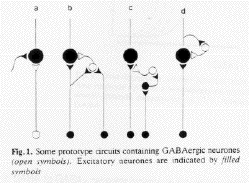
These notes were written for a lecture given to department trainees. The information contained herein, including the figures, has been adapted from sources listed in the bibliography.
STRUCTURE
FUNCTION
MECHANISM
Drugs may effect the function of the CNS therefore in 2 ways
generally:
NOTE: Drugs falling into Group 1 may have a very specific mechanism
of action (e.g., Benzodiozepines) but their consequences are
frequently diverse c.f. agents having specific group 2 effects which
can have very specific consequences.
Benzodiazepine Receptor (BZR) ligands, especially the classic
Benzodiazepines (BZs), are among the most specific centrally acting
drugs falling into the first group with respect to
GABA
GABAergic neurones
GABA receptors
* BZs act only on GABAA receptors *
|
|
GABAA |
GABAB |
|---|---|---|
|
Common agonist |
GABA |
GABA |
|
Selective agonist |
Muscimol |
Baclofen |
|
Selective antagonist |
Bicucculine |
Delta-Amino-valeric acid |
|
Effector |
Cl- channel |
Ca++ channel (inhib) |
|
Allosteric modulation |
Benzodiazepines |
|
The GABAA receptor
* This forms the basis of the inhibitory function of the
GABAergic system. *
Some examples of how GABAergic inhibition is thought to work:

The significance of GABAergic inhibition can be demonstrated by
blocking it e.g. with GABA receptor blocking agents :
1975 - First suggestion that classic BZs (agonists) acted by
enhancing GABAergic inhibition.
Since shown that BZ agonist facilitation of GABAergic transmission
occurs in all areas of the CNS where GABAA receptors have been
found.
BZR distribution has been shown to coincide with GABA receptor
distribution by autoradiograms of animal brain sections after
treatment with 3H-diazepam and more recently by P.E.T. scanning of
live animal and human brains after injection with 11C-Flumazenil.
Radioisotope and Flourescent BZR bigands have also been used to
demonstrate their high affinity and high specificity for the BZR and
also the fact that these sites are saturable.
Studies of the action of BZR agonists on the GABAergic system have
shown the following :
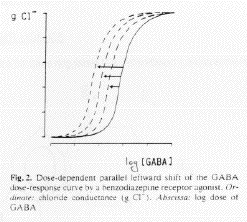
In 1985 the BZR was isolated using monoclonal antibodies and it was
found that as well as BZs it bound GABA, leading to the conclusion
that the GABAA receptor and the BZR were both part of one complex,
the GABAA - BZR - Cl- channel complex.
This was comfirmed in 1987 when DNA for alpha and beta subunits of
the complex were cloned and injected into cells not normally having
GABAA receptors, resulting in the synthesis and membrane inclusion of
fully functional GABAA - BZR - Cl- channel complexes. The gCl- of the
cells varied in the predicted manner in response to GABA before and
after addition of BZs .(No response was seen with addition of BZs
alone). This confirmed the theory that the BZR is an allosteric
modulatory site on the GABAA receptor and that GABA and BZs
allosterically modulate each other's binding to their respective
receptors.
It was thought in 1987 that the receptor complex contained 2 a
subunits (containing the BZRs) and 2 b subunits (containing GABAA
receptors) but by late 1990 subunits of 4 classes (alpha ,beta ,
gamma , delta) had been identified and coded with even further
subdivision within the classes. Diverse structural and
pharmacological heterogeneity of the complex has now been
demonstrated.
It has also been shown in the 2nd half of the 1980's that the GABAA
receptor complex occurs in virtually every neuron in the brain, on
glia, and also exists in the periphery.
BASIC STRUCTURE OF BZR LIGANDS
The core of all BZR ligands is a benzene ring joined to a 7-membered
1,4-diazepine ring:
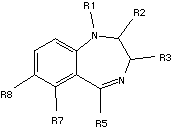
The various substituents determine the ligand's pharmacological properties:
THE BZR AGONISTS (The Classic Benzodiazepines)
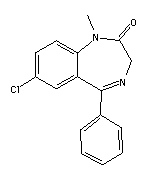 DIAZEPAM
DIAZEPAM
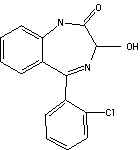 LORAZEPAM
LORAZEPAM
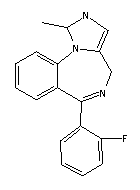 MIDAZOLAM
MIDAZOLAM
all produce the same effects ( to varying degrees )
THE OTHER LIGANDS
 MIDAZOLAM: an agonist - intrinsic
efficacy +1.0
MIDAZOLAM: an agonist - intrinsic
efficacy +1.0
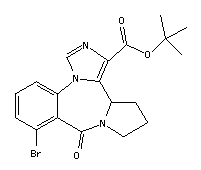 Ro 16-6028: a partial agonist -
intrinsic efficacy +0.5
Ro 16-6028: a partial agonist -
intrinsic efficacy +0.5
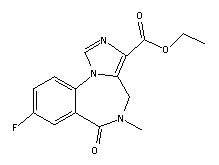 FLUMAZENIL: an antagonist -
intrinsic efficacy 0
FLUMAZENIL: an antagonist -
intrinsic efficacy 0
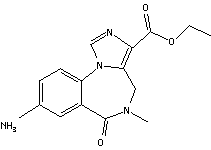 Ro 15-4513: a partial inverse
agonist - intrinsic efficacy -0.5
Ro 15-4513: a partial inverse
agonist - intrinsic efficacy -0.5
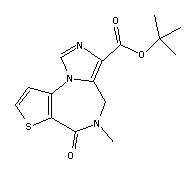 Ro 19-4603: an inverse agonist -
intrinsic efficacy -1.0
Ro 19-4603: an inverse agonist -
intrinsic efficacy -1.0
NON BENZODIAZEPINE BZR LIGANDS
THE QUESTION OF ENDOGENOUS LIGANDS
The first studies of the respiratory effects of diazepam were carried
out in the late '60s. They examined CO2 responses only and most
concluded there was no effect.
In 1971, Catchlove & Kafer used Read's rebreathing technique for
the first time to examine the effect of 0.14mg/kg (10mg/70kg) i.v.
diazepam on CO2 responses and steady-state gas exchange. VT decreased
20%, PaCO2 increased 19%, and VD/VT increased 34%. The slope of the
CO2 response was depressed in 46%, unchanged in 23% and increased in
the rest. 84% showed a rightward shift.
Forster et al (1980) studied deltaVE/deltaPETCO2 and
deltaP0.1/deltaPETCO2 after 0.3mg/kg diazepam and 0.15mg/kg midazolam
i.v.. Both drugs depressed both variables to a similar degree. No
rightward shift could be demonstrated.
Gross et al (1982) showed the CO2 response to be depressed
significantly for at least 25 minutes after 0.4mg/kg i.v. diazepam.
The degree of depression correlated well with the level of sedation.
Again no right shift demonstrated.
Power et al (1983) claimed neither 0.15mg/kg diazepam nor 0.075mg/kg
midazolam i.v. caused depression of the CO2 response despite the mean
slopes falling to 0.72 and 0.60 of their control values respectively.
Main problem was n=7 (i.e. Power had no power! :-)
Alexander and Gross (1988) demonstrated a 53% decrease in the slope
of the isohypercapnic (PETCO2 50mmHg) hypoxic response
(deltaVE/-deltaSaO2) after 0.1mg/kg midazolam i.v. It also
obliterated the haemodynamic response to hypoxia.
Gillis et al (1988) performed an elegant study where they applied
various BZR ligands to the intermediate area of the ventral surface
of the medula of cats anaesthetised with a-chloralose. Both midazolam
(0.75-250mg/side) and chlordiazepoxide (100-1000mg/side) caused dose
related depression of VE, VT, heart rate and blood pressure, although
some tachyphylaxis was demonstrated. Respiratory frequency did not
change. The effect was evident within 1 minute and lasted 30-60
minutes. Application of the agents to the rostral area caused neither
effect and application to the caudal area caused hypotension without
depressing respiration. Only the largest of these doses given i.v.
had any effect but increasing i.v. doses (up to 1.0mg/kg midazolam)
produced the same dose related response as the smaller topically
applied ones, with the addition of depressed resiratory rate.
Topically applied flumazenil (250mg/side) and bicuculline (a
selective GABAA antagonist - 10mg/side) had no effect on their own
but both prevented (if applied before) and reversed (if applied
after) the depression caused by midazolam whether it was given
topically or i.v. Ethyl-beta-carboline-3-carboxylate (a BZR inverse
agonist - 12.5-30mg/side) applied topically to the medulla caused the
opposite effects to midazolam and was also reversed by
flumazenil.
Also in 1988, Skatrud et al examined the effects of up to 3 times the
normal oral dose of triazolam. They claimed no effect on VE (VT
decreased and f increased). However, they had a similar result with
0.15mg/kg i.v. morphine (a fairly big dose) and their intersubject
variability was very large.
In 1990, Wettstein, Teeple and Morse examined the effects of a
variety of BZR ligands and other agents (given i.v.) on the
respiration of awake rhesus monkeys. The BZ agonists alprazolam
(0.01-1.0mg/kg), lorazepam (0.3-10.0mg/kg) and quazepam
(1.0-5.6mg/kg) all depressed VT and VE during both 5%CO2 and air
inhalation. Pentobarbital (3.0-30mg/kg) also depressed frequency and
it's dose/effect relationship on VT was steeper. Two beta-carbolines
(beta-CCE (0.3-5.6mg/kg) and FG 7142 10mg/kg)) increased frequency
and VE. Both flumazenil and CGS 8216 (a weak inverse agonist)(both
1.0mg/kg) reversed the effects of the agonists. Alprazolam reversed
the stimulation of FG 7142.
Dahan and Ward claimed in 1991 that midazolam (0.025mg/kg followed by
infusion at 1.0mg/70kg/h - a piddling dose!) did not reduce the acute
ventilatory response to isohypercapnic hypoxia. In their discussion
however they state there was a reduction but it failed to reach
significance, hardly surprising when there were only five subjects
and the PETCO2 was actually higher in the midazolam experiments! The
midazolam also caused a greater hypoxic ventilary decline.
Gross, Weller and Conard reversed midazolam (0.13mg/kg) with
flumazenil (1.0mg/kg) and found that the sedation and right shift of
the CO2 response were rapidly reversed but the depression of the
slope of the CO2 response was not.
Blouin et al (1993) confirmed midazolam's (0.12mg/kg) depression of
the isohypercapnic hypoxic ventilatory response (deltaVE/deltaSpO2
reduced to 59%). This was fully reversed with flumazenil (1.0mg/kg).
BZR agonists almost certainly cause dose-related centrally mediated
(medullary) respiratory depression. VT seems to be affected more than
frequency and the sites of these actions may be different. Inverse
agonists cause the opposite effect and pure antagonists reverse the
effect. Flumazenil may not be a pure antagonist given the variability
in it's reversal of the effects of agonists on ventilatory responses.
Alternatively, the level of receptor occupancy may play a role in
these differences.